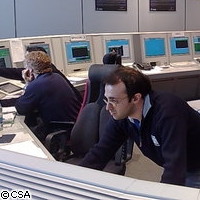ESA makes space missions a family affair
The European Space Agency (ESA) is combining and sharing operations methods, facilities and procedures in a bid to fuel cooperation and efficiency and cut costs. The 'Mission Family' concept is being applied to all Earth Observation (EO), Astronomy and Fundamental Physics and Solar and Planetary missions controlled from the European Space Operations Centre (ESOC), specifically those situated in the Dedicated Control Room (DCR). ESA scientists said the combination of spacecraft operations engineers and technical infrastructure gives a huge boost to efficiency and resources. Case in point is the flight-control teams operating the two veteran Earth missions Envisat and European remote-sensing satellite (ERS)-2. And following the launch of ESA's new Earth Explorer satellite 'Gravity field and steady-state Ocean Circulation Explorer' (GOCE) in March, the scientists believed it made sense to situate the new team members in the combined DCR as well. 'The launch of GOCE offered yet another opportunity to further improve and expand the degree of integration between Earth observation mission teams,' said Dr Manfred Warhaut, ESA's head of Mission Operations at ESOC. Until now, the flight-control team had to transfer its routine operations from the ESOC-based main control room to the smaller DCR when the satellite was launched, and the 'launch and early orbit phase' ended. For his part, Dr Pier Paolo Emanuelli, ESA's head of the Earth Observations Operations Division at ESOC, commented that the Mission Family concept offers engineers and spacecraft engineers the tools they need to cross-train on each others' satellites. The end result, he said, is heightened job satisfaction, increased support between colleagues and peers, and more know-how. 'Yes, we've been able to optimise personnel, and, with common training, our overall workload can be better managed,' Dr Emanuelli explained. 'The engineers have greater satisfaction; they can rotate between different phases of each mission and this gives them much more interesting professional opportunities,' he added. 'With ESA's growing EO missions, the time-limited testing campaign we experienced around the GOCE launch will occur more frequently. We can't just work harder; we have to work smarter and better.' Apart from the GOCE launch, ESA has also scheduled the launching of Cryosat-2 and the Soil Moisture and Ocean Salinity (SMOS) missions for this year. Cryosat-2 will monitor exact changes in the thickness of the polar ice sheets and floating sea ice, while SMOS will observe soil moisture over Earth's landmasses and salinity over the oceans. For the period from 2010 to 2013, ESA plans to launch Swarm, a mission to survey the geomagnetic field and its temporal evolution; Atmospheric Dynamics Mission (ADM)-Aeolus, which will improve understanding of atmospheric dynamics and climate processes and develop better weather forecasts; and EarthCARE, a joint European-Japanese mission that will focus on gaining more insight into the interactions between cloud, radiative and aerosol processes that contribute to climate regulation.



